The adventure to the ancient Inca city of Choquequirao
It is possible that when you are more than halfway to the Inca city of Choquequirao, thoughts of a beach, your feet in the sand, palm trees and an ice-cold juice will slip into your mind, and you will wonder what you are doing there, heading to a city of stone, doing the opposite of a vacation, which is the equivalent of physical rest? Then you will see mosquitoes that will bring you out of your thoughts. You will see people dressed in traditional costumes, working crops of all colors, donkeys and other farm animals, including llamas, grazing. A muleteer on horseback moving at the speed of Neymar may make you a little envious.
- Choquequirao, a great adventure
- Advantages of going to the Choquequirao ruins at this time
- The Choquequirao story
- On the way to Choquequirao
- Back home
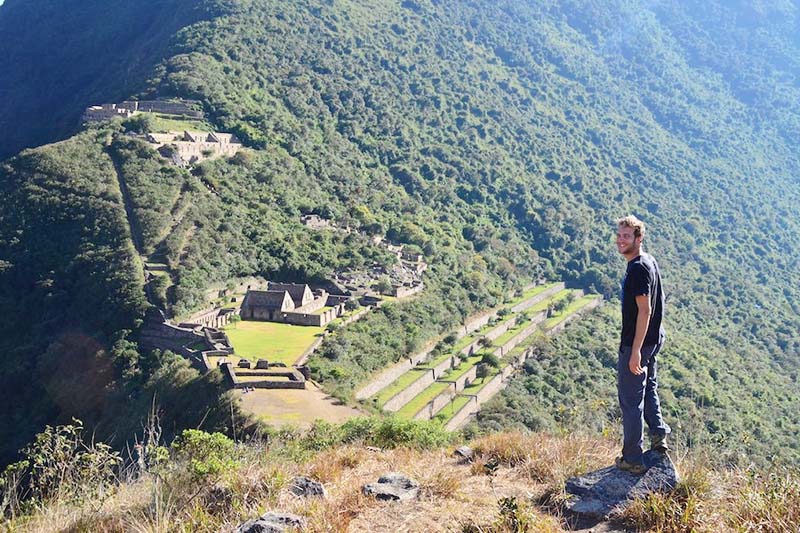
Tourist with the background of Choquequirao
You may feel short of breath at times, but it’s not just the altitude. The cornices, the jungle, the light that slips through the trees, the rainbows and the noises in the undergrowth, as if someone were accompanying you, but without wanting to be seen. When you hear this, be certain that you are hiking to a remote place between the mountain range and the jungle, the ancient city of Choquequirao.
Choquequirao, a great adventure
When you start the journey to Choquequirao from the edge of a hill, you will have to cross three mountains, cross the Apurimac River and then go up and down a path that winds through clouds that often touch each other to rain; when you have land on your face, you will feel that nature owns you. Something you should know, is that not for everyone, it is not Machu Picchu and its possibilities to get there, by train, on foot or by bus, and that it is not something whose planning you should take lightly. It is an Inca experience of deep meaning, capable of expanding the consciousness, directly related to the desire to arrive, the uncertainty of what is missing and the conviction, apparently innate in people who decide to take the walk to reach Choquequirao, even if you have to sweat for every toe or ask forgiveness to the Pachamama.
Every effort has a reward and in this case: it is an ancient city with stone structures five centuries old, 3,100 meters above sea level; terraces that in the past were the main cultivation lands to maintain the city, scattered along the steep slopes of mountains guarded by condors, temples, walls decorated with figures of llamas and alpacas, community houses; a whole museum of sculptures of the past, preserved at the level of the sky.
Advantages of going to the Choquequirao ruins at this time
- Far away from everything: that is another fundamental value, another reason why it makes sense to walk 53 kilometers, during 5 days, to those constructions in the middle of the jungle. The Inca city of Choquequirao is still a place to be discovered.
- There is no one on the trail: or at most, a few other trekking enthusiasts – mostly young Europeans – the people you will meet along the way, at small rest stations and campsites in between.
- You can tour the city alone: not to detract from the beauty of the wonder, but yes, Machu Picchu is visited by thousands of people every day. In Choquequirao you will not see more than 30 adventurous people.
In a present of incredible destinations promoted even in little boxes of phosphorus, it is difficult to enter and visit a historical monument of the magnitude of Choquequirao practically alone. This is another aspect that justifies with creses the sacrifice of walking to this city. In addition, for now, you do not have to book your entrance tickets so far in advance, as in the case of Machu Picchu tickets to enter the Huayna Picchu mountain, or the entrance tickets to walk the Inca Trail to the Sun Gate. In addition, in Choquequirao and other historical sites in the middle of mountains, the journey ends when you return to the starting point. So you have nothing left to do but retrace every step you have taken.
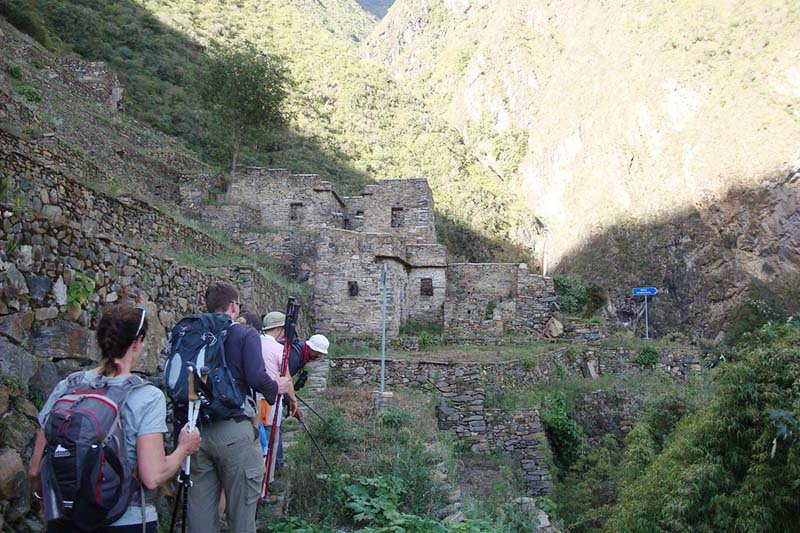
Walking through the constructions of Choquequirao
The Choquequirao story
If you believe that Choquequirao was discovered by a North American foreigner with a khaki hat, who asked some of the descendants of nearby families if they had heard of an ancient Inca city in the middle of the jungle, just like Machu Picchu; well, you are right, indeed, it is the same North American with a khaki hat. This foreigner hired a local shepherd as a guide, paid him for some donkeys and they started walking. Choquequirao means “cradle of gold” and was discovered by Hiram Bingham in 1909. However, while Machu Picchu achieved full glory. What is considered its sacred sister (Choquequirao) was covered by the dense jungle for much longer. And it was not until 1986, that the Peruvian government began the restoration work that made it possible, just some time ago, that people can reach the Inca city of Choquequirao, following in the footsteps of Bingham.
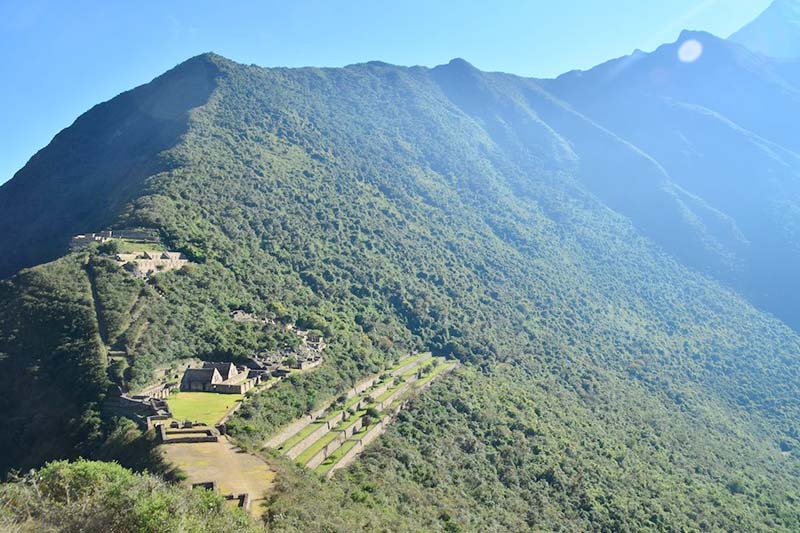
View of the central plaza of the Inca city of Choquequirao
On the way to Choquequirao
The journey begins at the Cusco airport, after a stopover in Lima. It is the starting point and the place where you will begin to feel the physiological effects of exposure to altitude, the 3,400 meters of the city of Cusco, can make people from any coastal city, feel discomfort, take it as a symbolic price you pay for entering the atmosphere of religious and cultural syncretism of the ancient capital of the empire of the Incas. There are several ways to avoid the symptoms of altitude sickness, you can start by resisting the temptation of that pagan god called pisco sour.
You will board a van through winding roads and leave behind all traces of connection with everyday life, this vehicle will leave you in the village Cachora, from that moment you must walk, you can not stop or you risk staying in the middle of nowhere. And the classic trekking situations will begin; right where the car road ends, inside the post that works as a shelter and where you can stock up and have a hot drink before leaving. The place is called Abra Capuliyoc (at 2,850 meters above sea level). There is a small wooden table (somewhat puny), a map, mosquitoes, backpacks. You will be surrounded by the immensity of the mountains, white landscapes covered with snow, and a gorge that causes vertigo. Peru with open veins.
Your team
You will have a team of porters, a cook, a guide and beasts of burden with the camp in tow, the team arrives in advance to the camping sites, to wait for you with the camp set up and the food ready. A luxury if you take into account that you will walk between 8 and 10 hours per day. You will appreciate it.
First day of trekking to Choquequirao
On the first day you will have the challenge of a 1,600 meter descent over 15 km to the banks of the Apurimac River, it is key to use poles so as not to overload your legs; walk at your own pace and do not rush. A mountaineering maxim holds that “those who go slow, arrive safely”. Economizing your energy means that you will have some to enjoy the dinner and the chatting during it. After 8 hours of rest until about 4 a.m., you will have a quick breakfast, usually based on Andean cereals.
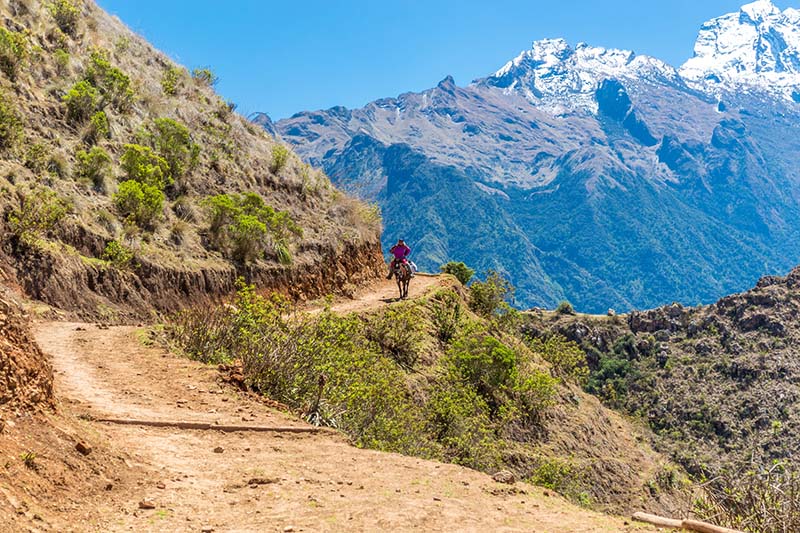
Road to Choquequirao
Second day of trekking to Choquequirao
The second day is a challenge for the body and mind, climbing 1,500 meters to reach 3,100 m.a.s.l. following a zigzag along the vertical slope of the mountain. It is not about climbing, but following a path with great care, it requires lungs, effort and concentration. There is only one thing that can improve the scenery and that is a little rain to bathe them under the intensity of the sun and of course one or two rainbows. You can also imagine the people who traveled that same path, carrying food, metals and other valuables between the main cities of the empire.
Arrival at the ruins
From Marampata at 2,910 m.a.s.l. there is almost nothing left before you reach the ruins. Here you will have two options: sleep in the camp and arrive at the ruins very early in the morning, or move on that same afternoon and return to the tent at night. It is an hour’s walk along a jungle trail, among ferns and orchids. Nearby there are gates, tiles and a direct corridor to an aqueduct; stairs from centuries ago, signs of the proximity of the city. Finally you will enter the city through an old priestly house and you will be stepping on the central platform of Choquequirao. Objective accomplished.
You will be able to wander, from a huge room of about 150 meters in diameter, through stairways and passageways that lead to other rooms, temples, residences, sacred places and others. This place could have been a religious altar. You will also be able to perceive the echo of his voice, and descend to the cultivation terraces, where 22 figures of llamas carved as cave paintings appear. You will be able to notice, at first sight, the mathematical logic that governs the constructions and the Inca pretension to dominate everything from above. It is possible that like the Inca city of Machu Picchu, this may have served as a link to unite the Andes of Cusco with the Amazon jungle.
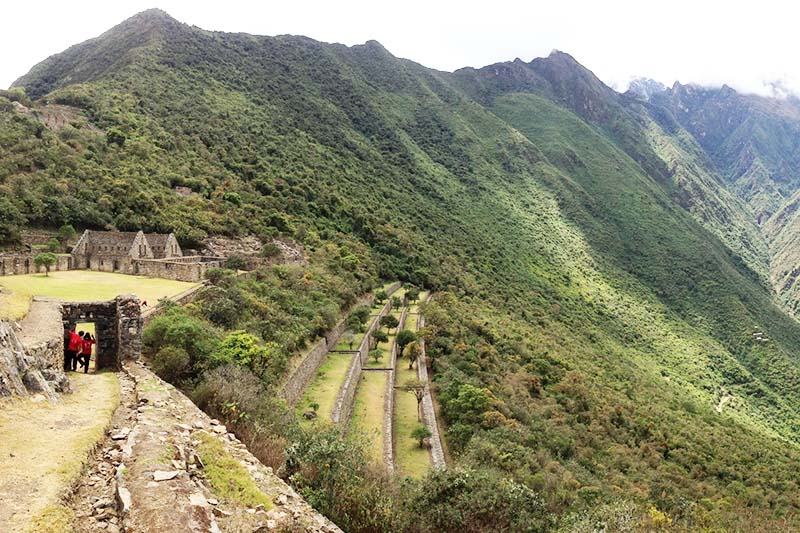
Entrance to the central plaza of Choquequirao
Back home
Two days later, on the way back you will wake up with the view of the Apurimac valley, in a place known as Cocamasana. You will start your last day of trekking at 4 am and will be at the Capuliyoc refuge at 8 am. The idea is to find yourself and feel alive (organic and functional). After finishing this hike, you will feel some happiness to be back to civilization, say goodbye to the porters, meet the driver, who days ago, left you at the beginning of the hike. We assure you that when you arrive in the city of Cusco, you will want to celebrate the journey with wine.
Whether you want to visit Choquequirao, Machu Picchu or any other city in the Sacred Valley of the Incas, contact us at info@boletomachupicchu.com, we will help you plan your trip.
Advice from people who have been there
 By: Jean F.
By: Jean F.“I prefer Choquequirao to Machu Picchu“
“I prefer to say that “I am one of the hundreds who have visited Choquequirao” than to say that I am one of the millions who have visited Machu Picchu. I had the opportunity to visit both Inca cities in the same trip and there is only one thing I can tell you. Machu Picchu is one of the best sightseeing you can have (maybe in the whole world), but Choquequirao is one of the best excursions you can have (maybe in the whole world).“
By Ticket Machu Picchu – Last updated, July 22, 2024